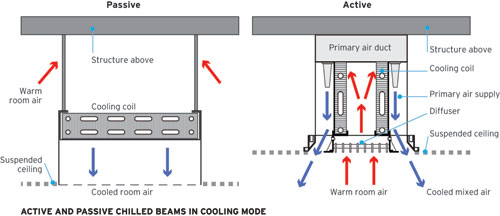Energy Efficiency in Buildings
DEFINITION & TYPES OF STRATEGIES
Buildings take part in the GHG emissions and in energy consumption. In 2010 buildings meant a 32% of total global final energy use and a 19% of energy‐related GHG emissions (approximately one‐third of black carbon emissions).
Technologies
HIGH-PERFORMANCE BUILDING ENVELOPE(HPE)
The building envelope is the boundary between the conditioned interior of a building and the outdoors. Building components like external walls, floors and roofs are important to determine the amount of energy that is required for heating or cooling the building.
Heating and cooling the buildings by means of the envelope of the building, can save around 30% of the energy consumption, rising to 50%-60% in cold climates.
Building envelopes were inefficient in the past (single pane windows, high air leakage, no insulation…) but currently they are being converted into buildings with energy savings (double glazed windows, low air leakage, high levels of insulation). It is projected that buildings will be zero-energy buildings with highly insulated windows, optimized designs and daylighting.

EFFICIENT APPLIANCES(EA)
There are appliances which are energy-efficient. They are able to save up to $400 per year. New appliances (washers, dishwashers, air conditioner…) use less energy than the old ones. For example, new clothes washers use 70% less energy and new air conditioners use 50% less energy. If we do not need to buy a new appliance, we can use the existing appliances more efficiently so that we can extend the working life of them. If each of us increases the energy-efficiency in out appliances by 30%, we will release the demand for electricity by the equivalent of 25 power plants.
Examples of how to increase the energy-efficiency of an appliance are:
- Never run frost-free refrigerators with freezer compartments in unheated areas with air temperature below 60 degrees F.
- Make sure the oven door seal is tight. Avoid opening oven door while baking – each time the door is opened, about 20% of the inside heat is lost.
- When you use the washer, you should avoid using too much detergent. Overusing makes your machine work harder and use more energy.
- If buying a new air conditioner, choose a model with an Energy Efficiency Ratio (EER) of 10.0 or higher.
If all homes in Europe changed their more than ten-year-old appliances into new ones, 20 billion kWh of electricity would be saved annually, reducing CO2 emissions by almost 18 billion kg. The energy required by an appliance depends on the moment of the day. For example, an air conditioner uses more energy during the afternoon when it is hot than during the night.
EFFICIENT LIGHTING
Lighting is about 15% of an average house’s electricity use. If we want to achieve a more energy-efficient lighting, bulbs have to be replaced by compact fluorescent light bulbs (CFLs) or light emitting diodes (LEDs). Incandescent bulbs are based on old technology and waste 90% of their energy as heat. Compact fluorescent light bulbs are the cheapest and the most effective choice in lighting. A CFL produces the same amount of light than a conventional bulb (incandescent bulb) but it uses 75% less energy, produces75% less heat, and lasts up to 10 times longer than incandescent bulbs. These bulbs contain mercury so we have to recycle them at the end of their life period.

LEDs are more efficient and provide higher quality than CFLs. LEDs use roughly 75 percent less energy than incandescent bulbs, emit no heat, and last 25 times longer. LEDs use light emitting diodes to produce light very efficiently.
Adoption of LED lighting could:
- Deliver energy savings
- Avoid the need to build new power plants
- Reduce electricity demand for lighting
EFFICIENT HEATING,VENTILATION,AND AIR CONDITIONING SYSTEMS(HVACS)
The electricity consumption of heating, ventilation and air conditioning systems accounts for 40% of building energy consumption. Improving the efficiency of these systems the demand of electricity can decrease.
What are the opportunities of HVAC systems?
REDUCING DEMAND OF HVAC SYSTEMS
Reducing demand of these systems is important and it can be achieved by means of different methods such as improved insulation, window glazing, natural ventilation and painting roofs white (which reduce air-conditioning loads by 20%). Optimising building design, assessing cool roof application, reducing heat generation from lighting and optimising temperature and humidity to save energy are ways to reduce the demand of HVAC systems.
UPGRADING HVAC SYSTEMS
•Installing HVAC systems in milder climates can achieve electricity savings.
• Using more efficient technologies: according to the IPCC modern technologies can enable reductions in HVAC systems demand of at least 50%. In this way, buildings can use smaller HVAC systems and consume less energy and water. Some of these technologies are radiant chilled beams, displacement ventilation and climate control.
OPTIMIZING THE USE OF EXISTING HVAC SYSTEMS
• A good maintenance and control of HVAC systems can save energy. Control systems reduce HVAC energy consumption by ensuring that the right amount of air conditioning is provided when and where it is required. Control systems can shut down part of the distribution circuit be adjusted to prevent simultaneous operation of heating and cooling systems, and have default settings that are suitable for the building.
• Utilising thermostats: temperature controllers reduce energy consumption by activating various components of the HVAC system as the demand for its services arise.
• Optimising air distribution systems reduces costs, saves energy and improves indoor comfort. An increase in the air duct’s cross-sectional area by 15% will reduce the friction by 50% and reduce energy consumption with energy savings around 15–20%. Insulating ducts prevents undesirable heat transfer.
• Optimising ventilation systems to save energy by demand-controlled ventilation, variable speeds, preventing over-ventilation and insolating fan motors.


Displacement ventilation relies on the natural buoyancy forces of air to drive air motion. Warmer supply temperatures and lower velocity air are characteristic of these systems. A displacement ventilation system supplies conditioned cool air from an air handling unit through a low induction diffuser. The cool air spreads through the floor and then rises as the air warms due to heat exchange with heat sources in the space.
The warmer air has a lower density than the cool air, and thus creates convective flows known as thermal plumes. The warm air then leaves the zone at the ceiling height of the room. Diffusers can be located against a wall, at the corner of a room, or above the floor. Displacement ventilation can be coupled with other cooling and heating sources, such as radiant chilled ceilings or baseboard heating.
Benefits to the Environment
Energy savings implementing the technologies mentioned above (and others) are: ovens (45%), microwave ovens (75%), dishwashers (45%), clothes washers (28%), clothes dryers(50-75%), office computers and monitors (40%) and circulation pumps for heating and cooling (40%).
If we reduce the energy consumption enhancing the energy efficiency in homes and buildings, we are avoiding the emission of CO2 by means of burning fossil fuels in power plants.
Trends
Trends indicate the potential for massive increases in energy demand and its associated emissions. Buildings offer opportunities to reduce energy demand. Building envelopes are expected to save almost 6 exajoules in 2050 under the 2 degree Celsius scenario, equivalent to the current energy consumption of the United Kingdom. The roadmap establishes a strategy to transform how the world’s buildings are constructed and renovated.
In buildings some trends are:
- Investigating ground-source thermal options: ground-source heat pumps use the earth as a source for heating or as a heat sink for cooling. They reduce the temperature differential across which the HVAC system work.
- Modulating HVAC compressors can reduce energy consumption by about 20% and help to deliver better humidity control due to regular air flow.
- Dehumidification enhancement: in humid climates HVAC systems can better match cooling loads and reduce the need for reheating. They can reduce energy consumption by 30%.
- Future developments are advanced rooftop packaged air conditioners; active solar thermal that store sunlight by heating a fluid (normally water) in a collector; computerized control, and discovering new kinds of natural (or ecological) HVAC refrigerants.
